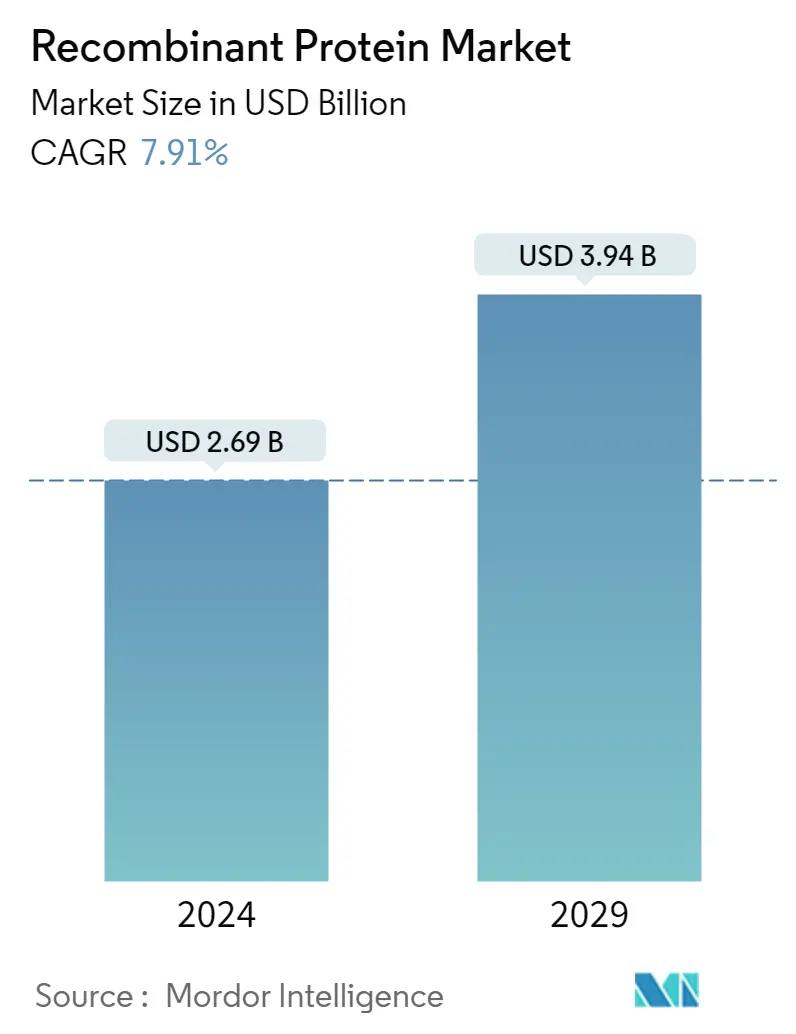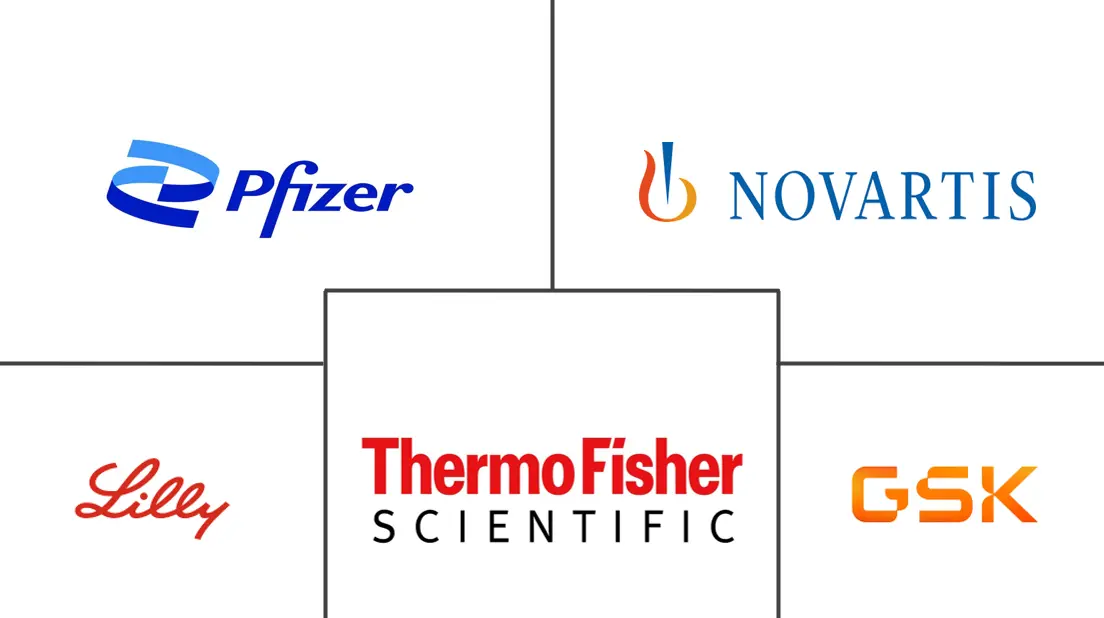Market Size of Recombinant Protein Industry

| Study Period | 2019 - 2029 |
| Market Size (2024) | USD 2.69 Billion |
| Market Size (2029) | USD 3.94 Billion |
| CAGR (2024 - 2029) | 7.91 % |
| Fastest Growing Market | Asia-Pacific |
| Largest Market | North America |
Major Players
*Disclaimer: Major Players sorted in no particular order |
Recombinant Proteins Market Analysis
The Recombinant Protein Market size is estimated at USD 2.69 billion in 2024, and is expected to reach USD 3.94 billion by 2029, growing at a CAGR of 7.91% during the forecast period (2024-2029).
The COVID-19 pandemic impacted the growth of the recombinant protein market. With the emergence of COVID-19, there has been an increased demand for therapeutic and vaccination measures to combat it.Many market players and public organizations shifted their focus to research and development activities for the treatment of COVID-19, and recombinant proteins played a vital role in these activities. For instance, an article published in the journal JCLA in May 2022 reported that researchers and scientists targeted recombinant proteins for COVID-19 vaccine development. Thus, COVID-19 sparked a surge in demand for recombinant protein-based medicines. However, in the current scenario, it is anticipated that, with the high prevalence of other chronic diseases and the presence of other infectious diseases, and the efficacy of recombinant protein-based medicine in its treatment, the studied market is expected to witness significant growth over the forecast period.
The factors that are driving the growth of the studied market are the increasing expenditure on research and development; the growing prevalence of chronic diseases; the aging population; the rising inclination towards biologics and biosimilars; and the launch of advanced recombinant products.
According to the American Cancer Society's 2022 statistics, in the United States, there will be an estimated 1,918,030 new cancer cases in 2022. Such a high burden of cancer creates the need for advanced therapeutics for the treatment, and since recombinant proteins are largely used in therapeutics and the development of cancer therapies, an increase in the cancer burden is expected to drive the demand for recombinant proteins, thereby driving the market's growth.
Additionally, increasing investments in research and development aimed at the introduction of new recombinant protein therapeutics also contribute to the growth of the market. For instance, in May 2022, an update from the National Institute of Health (NIH) of the United States reported that about USD 1,021 million had been invested in the year 2021 for the research and development funding for autoimmune diseases in the NIH of the United States, and it is further expected to increase to USD 1,061 million in 2022. Thus, such an increase in investment is leading to the development of recombinant-based protein medicines and thus fueling the growth of the studied market.
Furthermore, in September 2021, Aviva Systems Biology, one of the companies engaged in manufacturing and developing antibodies, immunoassay kits, and recombinant proteins for life science research, launched its new protein-on-demand, semi-custom recombinant protein portfolio for life scientists conducting basic research and preclinical studies.
Thus, due to the increasing expenditure on research and development, the growing prevalence of chronic diseases, the aging population, the rising inclination towards biologics and biosimilars, and the launch of advanced recombinant products The recombinant protein market is expected to project significant growth over the forecast period. However, the time-consuming and high-cost production processes and high costs may hamper the market's growth over the forecast period.
Recombinant Proteins Industry Segmentation
As per the scope of the report, recombinant proteins are encoded by recombinant DNA, which involves the insertion of the DNA encoding that particular protein into bacterial or mammalian cells. The protein is then purified after being expressed in these cells. Recombinant proteins are produced either by molecular cloning or by polymerase chain reaction (PCR).
The recombinant protein market is segmented by product (hormones, growth factors, antibodies, enzymes, and other products), application (therapeutic use, research applications, and biotechnology industry), and geography (North America, Europe, Asia-Pacific, the Middle East and Africa, and South America). The report also covers the estimated market sizes and trends for 17 countries across major regions globally. The report offers the value (in USD million) for the above segments.
| By Product | |
| Hormone | |
| Growth Factor | |
| Antibody | |
| Enzyme | |
| Other Types of Products |
| By Application | |
| Research Application | |
| Therapeutic Use | |
| Biotechnology Industry |
| Geography | ||||||||
| ||||||||
| ||||||||
| ||||||||
| ||||||||
|
Recombinant Protein Market Size Summary
The recombinant protein market is poised for substantial growth over the forecast period, driven by several key factors. The increasing expenditure on research and development, coupled with the rising prevalence of chronic diseases and an aging population, is propelling the demand for recombinant proteins. These proteins are increasingly being utilized in therapeutics, particularly for cancer treatment, which is seeing a surge due to the high burden of cancer cases. The market is also benefiting from a growing inclination towards biologics and biosimilars, as well as the launch of advanced recombinant products. The COVID-19 pandemic has further accelerated market growth by highlighting the critical role of recombinant proteins in vaccine development and therapeutic measures, although the high-cost production processes remain a challenge.
North America is expected to lead the recombinant protein market, supported by robust healthcare infrastructure, significant research investments, and the presence of major market players. The region's growth is further bolstered by the rising prevalence of chronic diseases, which drives demand for recombinant protein therapies. Additionally, novel research into neurodegenerative diseases like Alzheimer's is contributing to market expansion. The competitive landscape is moderately concentrated, with key players such as Abbvie Inc., Amgen Inc., and Pfizer Inc. holding significant market shares. Strategic activities like mergers, acquisitions, and new product launches are also shaping the market dynamics, ensuring continued growth and innovation in the recombinant protein sector.
Recombinant Protein Market Size - Table of Contents
-
1. MARKET DYNAMICS
-
1.1 Market Overview
-
1.2 Market Drivers
-
1.2.1 Increasing Expenditure on Research and Development
-
1.2.2 Growing Burden of Chronic Diseases
-
1.2.3 Rising Inclination toward Biologics and Biosimilars
-
1.2.4 Technological Advancements in Recombinant Products
-
-
1.3 Market Restraints
-
1.3.1 Expensive and Time-consuming Production Process
-
-
1.4 Porters' Five Forces Analysis
-
1.4.1 Threat of New Entrants
-
1.4.2 Bargaining Power of Buyers/Consumers
-
1.4.3 Bargaining Power of Suppliers
-
1.4.4 Threat of Substitute Products
-
1.4.5 Intensity of Competitive Rivalry
-
-
-
2. MARKET SEGMENTATION (Market Size by Value - USD million)
-
2.1 By Product
-
2.1.1 Hormone
-
2.1.2 Growth Factor
-
2.1.3 Antibody
-
2.1.4 Enzyme
-
2.1.5 Other Types of Products
-
-
2.2 By Application
-
2.2.1 Research Application
-
2.2.2 Therapeutic Use
-
2.2.3 Biotechnology Industry
-
-
2.3 Geography
-
2.3.1 North America
-
2.3.1.1 United States
-
2.3.1.2 Canada
-
2.3.1.3 Mexico
-
-
2.3.2 Europe
-
2.3.2.1 Germany
-
2.3.2.2 United Kingdom
-
2.3.2.3 France
-
2.3.2.4 Italy
-
2.3.2.5 Spain
-
2.3.2.6 Rest of Europe
-
-
2.3.3 Asia-Pacific
-
2.3.3.1 China
-
2.3.3.2 Japan
-
2.3.3.3 India
-
2.3.3.4 Australia
-
2.3.3.5 South Korea
-
2.3.3.6 Rest of Asia-Pacific
-
-
2.3.4 Middle East and Africa
-
2.3.4.1 GCC
-
2.3.4.2 South Africa
-
2.3.4.3 Rest of Middle East and Africa
-
-
2.3.5 South America
-
2.3.5.1 Brazil
-
2.3.5.2 Argentina
-
2.3.5.3 Rest of South America
-
-
-
Recombinant Protein Market Size FAQs
How big is the Recombinant Protein Market?
The Recombinant Protein Market size is expected to reach USD 2.69 billion in 2024 and grow at a CAGR of 7.91% to reach USD 3.94 billion by 2029.
What is the current Recombinant Protein Market size?
In 2024, the Recombinant Protein Market size is expected to reach USD 2.69 billion.

